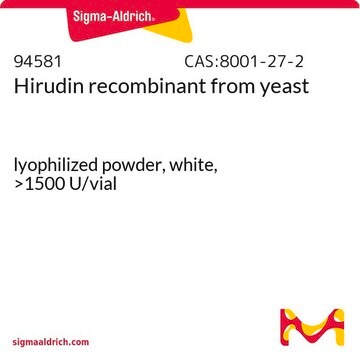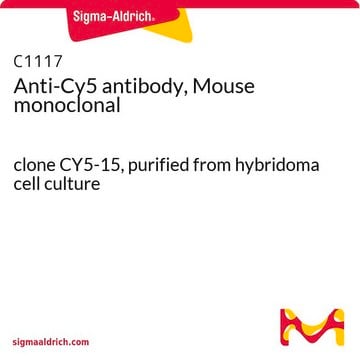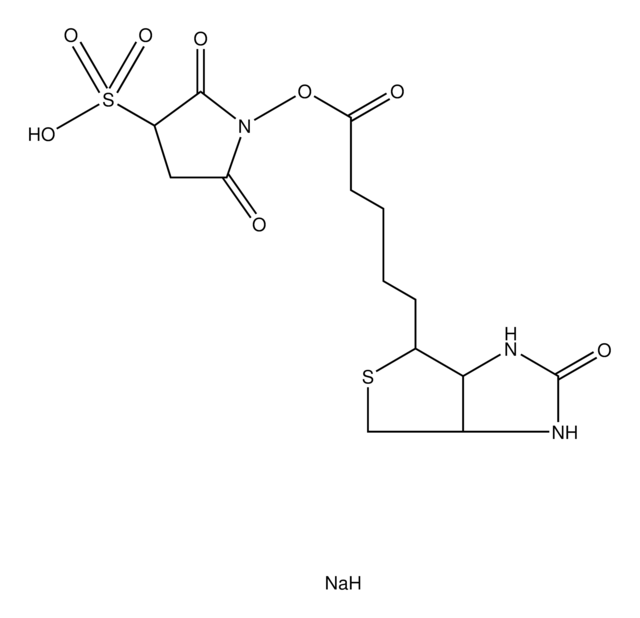推荐产品
生物源
mouse
共軛
unconjugated
抗體表格
purified from hybridoma cell culture
抗體產品種類
primary antibodies
無性繁殖
CY-96, monoclonal
形狀
buffered aqueous solution
濃度
~1.5 mg/mL
技術
direct ELISA: suitable
dot blot: 1-2 μg/mL using cell protein extracts labeded with Cy3 or Cy5
immunocytochemistry: suitable
immunoprecipitation (IP): suitable
microarray: suitable
同型
IgG2a
運輸包裝
dry ice
儲存溫度
−20°C
目標翻譯後修改
unmodified
正在寻找类似产品? 访问 产品对比指南
一般說明
Anti-Cy3/Cy5 antibody, Mouse monoclonal, (mouse IgG2a isotype) is derived from the hybridoma CY-96 produced by the fusion of mouse myeloma cells (NS1 cells) and splenocytes from Balb/c mice immunized with a mixture of proteins labeled with Cy3 or Cy5.
特異性
The antibody recognizes Cy3 and Cy5 conjugated to proteins.
免疫原
mixture of proteins labeled with Cy3/Cy5.
應用
Anti-Cy3/Cy5 antibody, Mouse monoclonal has been used in:
- immunofluorescence
- western blot
- dot blot
- enzyme linked immunosorbent assay (ELISA)
- immunoprecipitation
- immunocytochemistry
- protein microarrays
- In in situ hybridization
Applications in which this antibody has been used successfully, and the associated peer-reviewed papers, are given below.
Immunofluorescence (1 paper)
Immunofluorescence (1 paper)
生化/生理作用
Cy 3 and Cy5 are the most popular cyanine dyes, used combined for two color detection. Cy3 dyes are fluorescent orange while Cy5 is fluorescent in the red region. Cyanine belonging to polymethine group. CyDyes are a family of fluorophores that can be used for labeling proteins, peptides, DNA, RNA, and other biomolecules. These dyes are small, pH insensitive, soluble in aqueous solution and are tolerant to DMSO. They are more photostable than fluorescein, have high molar extinction coefficients and favorable quantum yields. Mainly Cy3 and Cy5 are used in many different biological assays such as DNA microarrays, protein microarrays, two-dimensional protein analysis (2D gels), fluorescence resonance energy transfer (FRET), and immunocytochemistry.
外觀
0.01M 磷酸缓冲盐溶液,pH 7.4,含 15mM 叠氮化钠。
免責聲明
Unless otherwise stated in our catalog or other company documentation accompanying the product(s), our products are intended for research use only and are not to be used for any other purpose, which includes but is not limited to, unauthorized commercial uses, in vitro diagnostic uses, ex vivo or in vivo therapeutic uses or any type of consumption or application to humans or animals.
未找到合适的产品?
试试我们的产品选型工具.
儲存類別代碼
10 - Combustible liquids
水污染物質分類(WGK)
WGK 3
閃點(°F)
Not applicable
閃點(°C)
Not applicable
個人防護裝備
Eyeshields, Gloves, multi-purpose combination respirator cartridge (US)
Chiaki Nagai-Okatani et al.
International journal of molecular sciences, 20(3) (2019-02-10)
Lectin microarray (LMA) is a highly sensitive technology used to obtain the global glycomic profiles of endogenous glycoproteins in biological samples including formalin-fixed paraffin-embedded tissue sections. Here, we describe an effective method for cell type-selective glycomic profiling of tissue fragments
An Improved Method for Cell Type-Selective Glycomic Analysis of Tissue Sections Assisted by Fluorescence Laser Microdissection
Nagai-Okatani C, et al.
International Journal of Molecular Sciences, 20(3), 700-700 (2019)
G Enders
Acta neurochirurgica. Supplement, 89, 9-13 (2004-09-01)
Microarray analysis has been emerged as a tool to characterize the overall reaction of cells in culture or tissue to different stimuli e.g. stressful events by analysing bulk RNA present at a particular time point. It has supplemented or even
Transplantation of ovarian granulosa-like cells derived from human induced pluripotent stem cells for the treatment of murine premature ovarian failure
Liu T. et al.
Molecular Medicine Reports, 13(6), 5053-5058 (2016)
A K Kenworthy
Methods (San Diego, Calif.), 24(3), 289-296 (2001-06-14)
Fluorescence resonance energy transfer (FRET) detects the proximity of fluorescently labeled molecules over distances >100 A. When performed in a fluorescence microscope, FRET can be used to map protein-protein interactions in vivo. We here describe a FRET microscopy method that
我们的科学家团队拥有各种研究领域经验,包括生命科学、材料科学、化学合成、色谱、分析及许多其他领域.
联系技术服务部门








